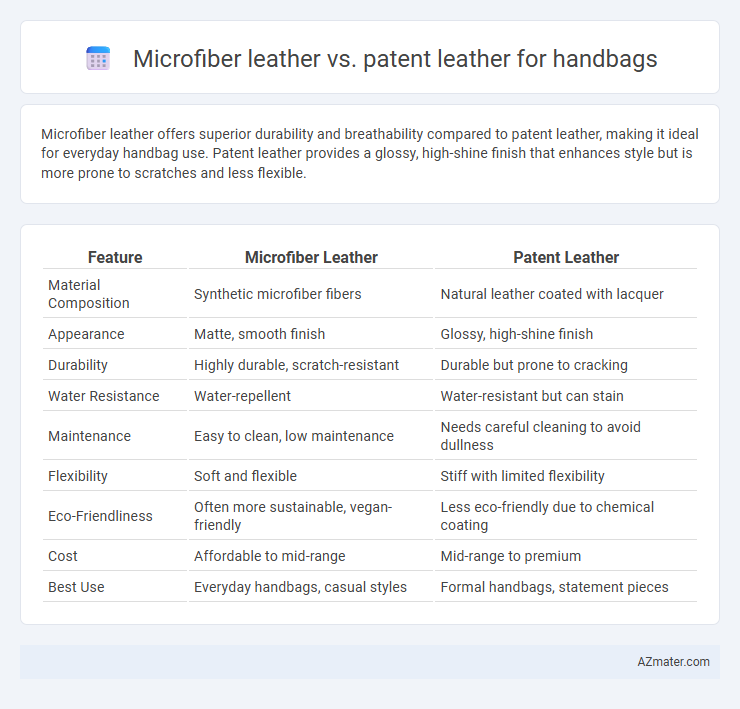Microfiber leather offers superior durability and breathability compared to patent leather, making it ideal for everyday handbag use. Patent leather provides a glossy, high-shine finish that enhances style but is more prone to scratches and less flexible.
Table of Comparison
| Feature | Microfiber Leather | Patent Leather |
|---|---|---|
| Material Composition | Synthetic microfiber fibers | Natural leather coated with lacquer |
| Appearance | Matte, smooth finish | Glossy, high-shine finish |
| Durability | Highly durable, scratch-resistant | Durable but prone to cracking |
| Water Resistance | Water-repellent | Water-resistant but can stain |
| Maintenance | Easy to clean, low maintenance | Needs careful cleaning to avoid dullness |
| Flexibility | Soft and flexible | Stiff with limited flexibility |
| Eco-Friendliness | Often more sustainable, vegan-friendly | Less eco-friendly due to chemical coating |
| Cost | Affordable to mid-range | Mid-range to premium |
| Best Use | Everyday handbags, casual styles | Formal handbags, statement pieces |
Introduction to Microfiber Leather and Patent Leather
Microfiber leather is a high-performance synthetic material composed of ultra-fine fibers tightly woven together, offering enhanced durability, breathability, and resistance to moisture compared to traditional leathers. Patent leather features a glossy, lacquered finish achieved through a coating process that creates a sleek, highly reflective surface often used for luxury handbags. Both materials provide distinct aesthetic and functional qualities: microfiber leather excels in flexibility and ease of maintenance, while patent leather is prized for its polished, eye-catching shine.
Manufacturing Process Comparison
Microfiber leather is produced through a synthetic process involving fine polyester fibers combined with a polyurethane coating, resulting in a durable, water-resistant material that mimics natural leather while offering enhanced breathability. Patent leather undergoes a manufacturing process where natural leather is coated with a lacquer or synthetic resin, creating a glossy, high-shine finish that is less flexible but highly resistant to moisture. The key difference lies in microfiber leather's entirely synthetic origin and layered fiber construction versus patent leather's natural base enhanced by a surface treatment for aesthetic appeal.
Appearance and Aesthetic Differences
Microfiber leather offers a matte, natural grain appearance that mimics genuine leather's texture, providing a sophisticated and understated aesthetic often preferred for everyday handbags. Patent leather features a high-gloss, reflective finish that creates a sleek, polished look, enhancing the handbag's visual impact with a bold and luxurious style. Both materials serve distinct fashion purposes, with microfiber leather emphasizing subtle elegance and patent leather delivering striking shine and vibrancy.
Durability and Longevity
Microfiber leather offers superior durability with its resistance to scratches, stains, and water, making it ideal for everyday handbag use. Patent leather, though stylish with its glossy finish, tends to be less durable due to its susceptibility to scuffs and cracking over time. For long-lasting handbags, microfiber leather provides better longevity, especially in varying weather conditions.
Water Resistance and Maintenance
Microfiber leather offers superior water resistance due to its synthetic coating that repels moisture, making it ideal for everyday use and wet conditions. Patent leather, while glossy and stylish, is less resistant to water and can develop water spots or stains if exposed to moisture frequently. Maintenance for microfiber leather is generally easier, requiring only a damp cloth for cleaning, whereas patent leather demands careful polishing to maintain its shine and prevent cracking over time.
Environmental Impact and Sustainability
Microfiber leather, made from polyurethane and polyester, offers a more sustainable alternative to traditional patent leather due to its lower water consumption and reduced use of animal products, decreasing its overall environmental footprint. Patent leather, derived from animal hides and coated with a high-gloss finish, involves intensive chemical processing and significant water usage, raising concerns about animal welfare and pollution. Choosing microfiber leather supports eco-friendly handbag production by minimizing resource depletion and toxic waste compared to the environmentally taxing manufacturing processes associated with patent leather.
Comfort and Weight Considerations
Microfiber leather offers superior comfort due to its breathable and flexible nature, making it ideal for handbags worn for extended periods. It is significantly lighter than patent leather, reducing strain on the shoulder or hand during use. Patent leather, while stylish and glossy, tends to be stiffer and heavier, which can lead to discomfort during prolonged wear.
Price and Cost-Effectiveness
Microfiber leather offers significant cost advantages over patent leather, making it a more budget-friendly option for handbags without compromising durability and appearance. Patent leather, often priced higher due to its glossy finish and natural leather base, incurs additional maintenance costs to preserve its shine and prevent cracking. Choosing microfiber leather ensures a cost-effective handbag investment by combining affordability with easy upkeep and long-lasting wear.
Popular Brands and Market Trends
Microfiber leather is increasingly favored by popular brands like Gucci and Stella McCartney for its durability, eco-friendly appeal, and resemblance to genuine leather, aligning with growing consumer demand for sustainable fashion. Patent leather remains a staple in luxury handbags from brands like Prada and Louis Vuitton, valued for its glossy finish and formal elegance, capturing consumers seeking classic styles. Market trends indicate a rising preference for microfiber leather as innovation in synthetic materials advances, while patent leather maintains steady demand in high-end, polished accessory segments.
Which Leather is Best for Handbags?
Microfiber leather offers superior durability, water resistance, and breathability, making it an excellent choice for handbags that require long-lasting performance and easy maintenance. Patent leather, characterized by its high-gloss finish and luxurious appearance, is more susceptible to scratches and requires careful handling to maintain its shine. For everyday handbags prioritizing functionality and resilience, microfiber leather is generally the best option, while patent leather suits formal occasions where aesthetic appeal is paramount.

Infographic: Microfiber leather vs Patent leather for Handbag
 azmater.com
azmater.com